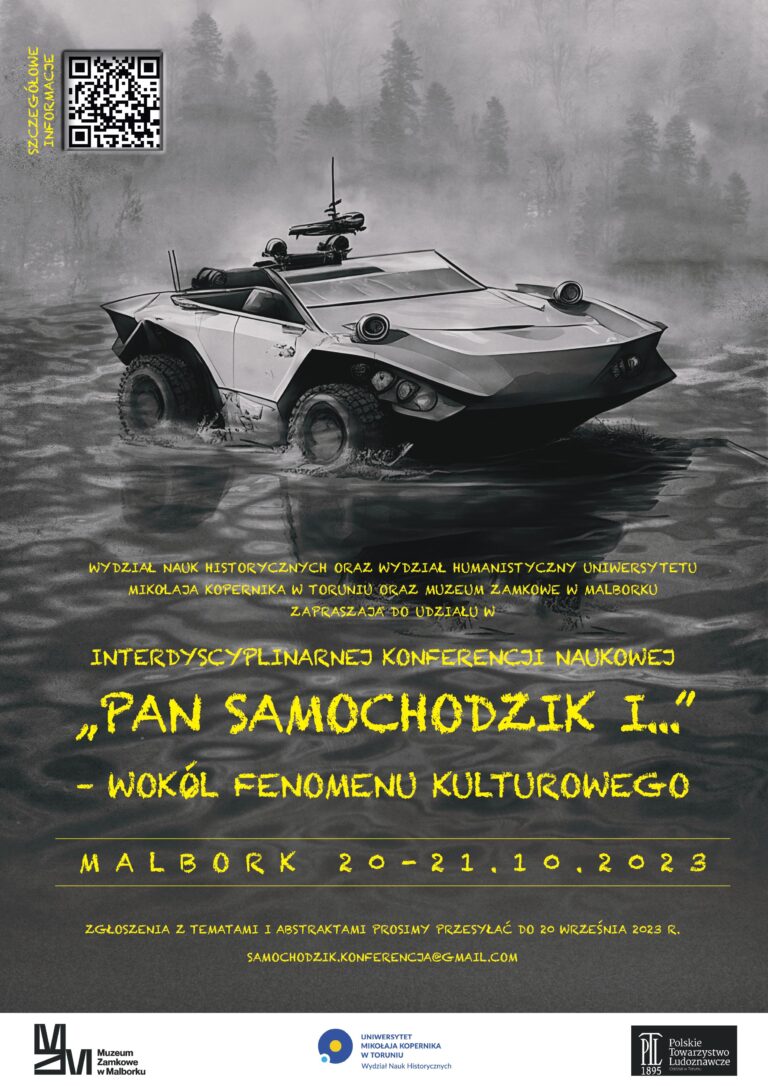News
“Mr. Samochodzik and…” around a cultural phenomenon. Interdisciplinary scientific conference.

Sixty-five years ago, in 1958, Tomasz NN, a journalist interested in archaeology, finished his studies (history of art) and soon after began working in the Department of Monument Protection of the Ministry of Culture and Art. A year earlier, it appeared in Zbigniew Nienacki’s novel Uroczysko (1957). As a journalist, we meet him in two other novels: Treasure of Atanaryk (1960) and Permission to import a lion (1961). Three years later, as an art historian, he solves the mystery of the Island of Villains. This is hiw one of the most important figures of youth culture (and not only) of the 1960s was born– Pan Samochodzik / Mr. Automobile.
The adventures of a clever and extensively knowledgeable detective who searches for lost works of art, struggles with cunning villains, reveals thefts and forgeries, which were written down by Zbigniew Nienacki in 15 volumes, captured the imagination of young people for several decades. Compared to Indiana Jones, Dirk Pitt and James Bond, he travels Poland in the company of beautiful women and young helpers, guarding the truth and protecting priceless monuments, in his trusty car, built on the basis of a crashed Ferrari 410 Superamerica.
The huge popularity of the series of adventures about Pan Samochodzik was confirmed by its subsequent reissues, film adaptations of individual volumes (including the mini-series Samochodzik and the Templars), as well as – which is a real, unique cultural phenomenon – the continuation of the series by other authors (currently 147 titles).
Such great popularity, the traces of which can be easily found even today, prompt us, the organizers of the conference, to ask a few questions.
- Whether, and if so, to what extent Pan Samochodzik and his adventures influenced the attitudes of young readers, especially in relation to culture and history, art, monuments and places of historical memory?
- How did the creation of this character and the description of his adventures contribute to shaping and/or implementing Polish historical policy in the years 1957-1985?
- To what extent did Nienacki’s hero influence other creators and authors (not only those who continue the series)?
- Who reads novels about the adventures of Pan Samochodzik today? Who’s watching it on the small screen? Can Pan Samochodzik be attractive to the contemporary young audience?
Drawing such a broad research perspective, we invite representatives of various scientific disciplines to participate in the conference, in particular: historians, literary scholars, sociologists, film scholars, linguists, art historians, political scientists, cultural scientists, and historians of ideas. We hope that among the research perspectives proposed below, you will find intriguing areas that require recognition and research. We propose to take such problems as:
- reception of the series and individual books, as well as related films (critics, readers, viewers),
- publishing and reissuing the series of adventures about Pan Samochodzik, reader circulation,
- relations: novels and films (including mini-series), Nienacki’s novels and novels of the series’ continuators,
- activities of fans and lovers of Pan Samochodzik,
- Pan Samochodzik analyzed against the background of young adult literature and adventure and detective novels,
- the role and importance of the book series and films in the formation of historical memory, including the “taming” of the Western Territories, Polish-German relations,
- the truth of history and the reality shown in the book series and films, omissions and blank spots,
- a series of books and films as a historical source (testimony of the PRL era, citizen-authority relations, film workshop of the 1960s),
- novel series and films as tools of propaganda,
- cultural patterns in Pan Samochodzik (e.g. social roles, the image of a policeman, male-female relations),
- novels and films as social phenomena,
- Pan Samochodzik in various forms of sharing (movies on VHS, DVD, on Internet channels, audiobooks, ebooks),
- the memory of Pan Samochodzik in public space, a point of reference for exhibition, museum and educational activities,
- new readings of novel series and films (feminist criticism, geopoetics, ecocriticism).
The conference is organized in hybrid mode.
Applications for the conference (attached form) are accepted until September 20, 2023. Paper proposals should be sent to the e-mail address: samochodzik.konferencja@gmail.com In the event of a large number of applications, we reserve the right to select the papers. We will inform you about the inclusion of the presentation in the program by September 27, 2023. The deadline for paying conference fees is October 6, 2023.
The cost of participation for people who come to Malbork is PLN 450; for online participants – PLN 200. The conference fee includes: preparation of conference materials, publication of post-conference materials, meals during the conference (for incoming guests).
We do not provide accommodation. Conference secretaries can help you book them.
Scientific Committee of the Conference:
Dr. hab. Marcin Hlebionek, prof. NCU (history)
Dr. hab. Rafał Moczkodan, prof. NCU (literary studies)
Prof. dr hab. Stanislaw Roszak (history)
Prof. dr hab. Jaroslaw Kłaczkow (history)
Prof. dr hab. Dariusz Brzostek (cultural studies)
Dr. hab. Katarzyna Kulpińska, prof. NCU (art sciences)
Prof. dr hab. Adam Grzelinski (philosophy)
Prof. dr hab. Marek Jeziński (journalism and social communication)
Dr. hab. Marcin Lisiecki, prof. NCU (philosophy and political science)
Conference secretaries:
Weronika Miczek
Marta Tumińska
Tickets
Buy tickets online
Opening Hours
- Mon - Sun:9:00 - 20:00
Exhibitions
- Tue - Sun:9:00 - 19:00
Contact
Tourist Information
- +48 55 647 08 00
- +48 55 647 09 02
- +48 55 647 09 78